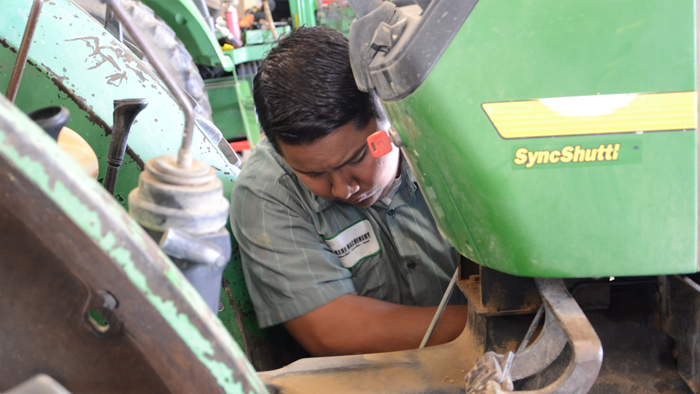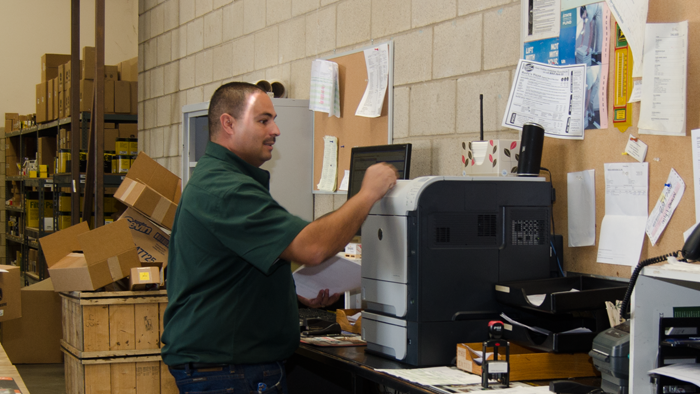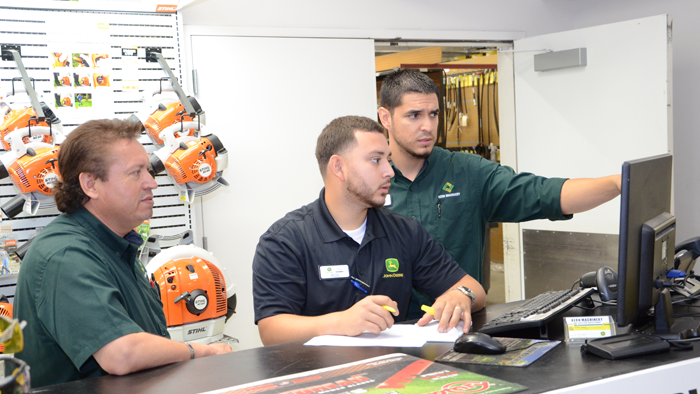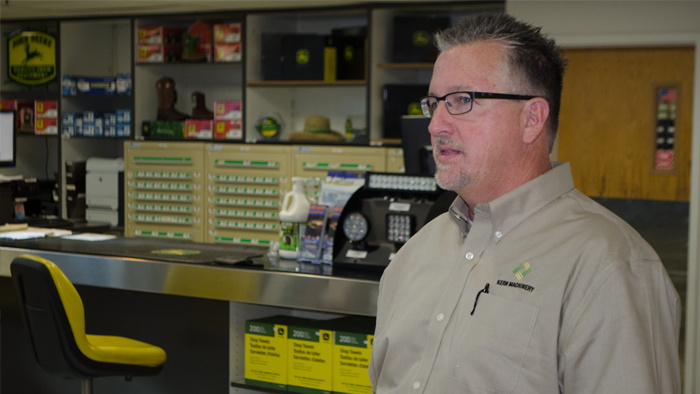Charlie Moe, Aftermarket Manager
Years with Operation: 5 Joined Kern Machinery after 20 years with AT&T in the cellular industry in various human resources, sales and general management roles.
Role: Oversees parts and service operations for all 4 locations and also champions Customer Experience, Branding and business promotions for the dealership. “I see myself in a support role for the overall enterprise,” Moe says.
“In terms of enterprise operations, I keep us all on the same track with planning, projects and key objectives coming up,” says Charlie Moe, aftermarket manager for Kern Machinery, in describing his role at the dealership.
As the aftermarket manager for the dealership, Moe oversees parts and service functions for the operation and is responsible for planning, often months ahead of time, for what resources the dealership will need or have to order and have in stock.
“My role is strategic,” he says. “I’m 6-12 months ahead of the aftermarket business most of the time, looking for opportunities, customer needs and planning where we’re going to be and what we’re going to need. I’m working with the parts managers looking for buying opportunities for new products while watching our inventory levels. On the service side, I’m looking at our wholegoods sales and technician man-hours and asking whether we have enough trained technicians to meet the demand. I’m also watching to be sure our techs are trained on our new products during downtimes instead of learning during peak season.”
While much of his time is spent crunching numbers, Moe says he wouldn’t be able to successfully plan ahead of time if it weren’t for the communication and teamwork he shares with the parts and service department teams and managers.
“When you’re looking 6-12 months out, while measuring today’s results, that takes a lot of coordination and planning. About every hour or so, I get up and walk though the dealership in Bakersfield where I do most of my project work to take the time to talk to the techs and the parts counter employees to hear and see what they’re seeing and ask how we’re doing,” he says.
Moe is also frequently traveling to Kern Machinery’s other locations and meeting with sales and aftermarket managers there as well.
“We are blessed geographically that we can easily get to all of our locations. I’m able to travel to each store and interact with the employees and customers. I try to stay as close to the business as I can and see how we’re doing and what we can improve upon while also looking for new opportunities,” he says.
All of this communication is what Moe says allows him to stay ahead of the business and industry to order, resource and prepare for what the dealership will need to better serve customers in the coming months.
“It all comes back to keeping that forward view of the business and being able to find the answers to the important questions. Are we headed in the right direction? Is there another opportunity? Do we need to course correct?”
Key Metrics
While Moe points out that there are an almost unlimited number of metrics one can measure, he says Kern Machinery focuses on a few key indicators. Aftermarket department managers present results to the leadership team and sales peers bi-weekly offering insights behind the numbers and allowing for information exchange and alignment between departments.
In the last several years, Kern Machinery transitioned to Charter Software's ASPEN dealership management system. Charlie Moe, corporate aftermarket manager with Kern Machinery of Bakersfield, Calif., explains how the capabilities introduced with the move to ASPEN have brought new efficiencies to the parts and service department and have enhanced the team's effectiveness and mobility. This video is part of the Dealership Minds Video Series, brought to you by Charter Software.
In parts, Kern monitors year-over-year sales by product category on a 2-week basis, reviewing YTD sales up to the past 2 weeks compared to what they were during the same period during the year prior. They also monitor overall sales year-over-year, as well as ticket counts per parts employee. This is then measured against the year-to-date revenue budget to gain perspective on where the dealership is compared to plan. These metrics are used to spot early trends and to adjust their tactics accordingly.
“From a customer’s eyes, it’s first time pass or fail. We want to have the right part the first time when they come in and have it in their hands quickly,” he says. Kern Machinery strives for a greater than 90% first pass fill rate for all of its parts but especially John Deere parts. Any lost sales are recorded by the parts specialists to capture missed opportunities, offer new product suggestions and be alert to parts and products to focus on in the future.
Parts inventory levels also are measured year-over-year by category with a target of 4 turns or greater in each line. Moe says they also track parts that have been on the shelf for 12 months without selling, which the dealership refers to as “zero sales,” with a target of under 8% of total inventory by category. When parts are stagnant Kern’s parts teams use vendor agreements to return them or offer discounts to move the parts out of inventory.
“We look at our John Deere inventory and then more specifically at our lines — garden equipment inventory, for example. Then we look at inventory by vendor and line and consider what parts we have of this or how many parts for that. We measure our turns and zero sales monthly and constantly move inventory around between stores to where it is selling,” he says.
In the service department, Kern measures year-to-date service sales by labor category, whether the service department is doing customer labor, internal labor or warranty labor vs. the year to date same period the year before. They also watch overall service revenue and work orders per technician. These numbers are then measured against their year-to-date revenue budgets. Moe says this all helps give them a view of where the work is coming from, how profitable it is, as well as employee productivity. Kern’s target for customer labor is to be greater than 50% of their total labor sales and balance that with the amount of internal and warranty labor being performed at lower margins.
“Service teams closely monitor these figures with the goal of growing our most profitable customer labor sales and of course our productivity,” Moe says.
In the bi-weekly leadership meetings service managers also present their metrics and are asked to give a projection of the work they have in the shops and committed ahead work to give the other departments a heads up on their workloads, which could impact internal labor requests. This helps the parts department manage inventory and gives the sales teams more time to plan for equipment set-ups.
Measuring Customer Satisfaction
While Moe measures a variety of metrics, he says the ultimate measure of success for the dealership and the sales, parts and service departments is customer satisfaction. Are customers willing to recommend Kern Machinery?
A primary goal of Kern Machinery is to make the growers they serve more profitable, more efficient and make their lives easier. Charlie Moe talks about how the dealership achieves that goal through proper management and efforts like parts transfers between locations. This video is part of the Dealership Minds Video Series, brought to you by Charter Software.
“On the service side, with our crops and weather climate we literally are working 24/7/365 if needed. Our customers need to know that we’re prepared to service them either in the shops or in the field. We make sure we have the right technicians and that they are equipped, trained and ready to go. We have to be there and be there quickly,” he says.
To measure customer satisfaction, Moe says Kern uses a combination of face-to-face interactions with customers and customer satisfaction surveys.
“We use the formal customer survey program managed by John Deere,” Moe says. “It asks specific questions like, ‘Are you willing to recommend this dealer?’ and ‘Are you willing to recommend John Deere?’ Those are valuable insights from our customers.
“We can also receive verbatim comments from our customers through the surveys. I’m the dealership representative for the surveys and I get all that data immediately, take a look at it and forward it out to the leadership team at the dealership and also to the manager who’s involved to recognize them and make sure they recognize their team for positive feedback from customers,” he says.
In addition to the surveys, Moe says the leadership team also makes an effort to talk to customers, from several levels in their large corporate farmers to the smaller operations, face to face.
“We talk to customers about their satisfaction with the work we’re doing when we bump into them at the stores or out in the field,” he says. “For our corporate farm customers with large staffs of employees of their own, we make a much more deliberate effort in getting feedback from them. Our field parts sales representatives have contacts at the farms and the service department will make contact with another person and each will ask, ‘What are we doing right?’ and more importantly, ‘What are we doing wrong? What could we fix?’
“Going to the customers and asking those questions and listening is one of the big keys to our success,” Moe says.
In addition to customer feedback, Kern also looks at year-over-year changes in numbers on a key customer-by- key customer basis.
“We look at what our year-over-year parts sales look like for specific customers, their service business and their wholegoods purchases. We pay attention to what they’re spending with us in total.
“It’s important to take notice of any changes in these numbers and find out if they’re on a buying cycle that’s different this year than it has been in years past or whether there has been a significant change in their operation. If there has been some kind of change with the customer, I want to know if my parts manager has gone out to find out why we’re off $10,000 year-to-date. I want to know what has changed — and why. Was it caused by something we did or did not do and if there is anything we can do to bring them back in,” Moe explains.
Managing Specialty Vendors & Parts
As aftermarket manager, Moe’s parts teams are responsible for keeping track of their parts inventory and ordering additional parts based on what they expect their stores will need. “In 2014 we created a parts operations manager position and promoted a veteran parts manager, Chris Schott to help us buy better with better terms, source new vendors, consolidate vendor accounts and oversee the coordination of the store parts managers. He has been a key profitability player working tactically with the parts managers.”
With the variety of crops being grown and harvested year round in California’s Central Valley, Moe says the dealership has many specialized equipment vendors to meet the needs of its customers. With many specialized equipment vendors come many parts.
“In addition to John Deere parts, we need parts for about 15 different shortlines,” Moe says. These are often transferred between each of Kern Machinery’s stores to meet customer demand without overstocking the enterprise.
“We have an enterprise parts runner who transfers parts between locations twice daily and can be tasked to drop off parts to key customers if needed,” Moe says. “To track and move those moving parts, we use our business system.
“In the John Deere legacy system we used to have, you were limited to looking only at an individual store’s inventory. With our current Charter Aspen business system, we’re looking at one screen with each store individually and the entire inventory for all of the stores. With that visibility, if we’re searching for a part it’s very easy to tell where it is. If we don’t have the part in Buttonwillow, the Bakersfield or Delano stores often have it.”
As far as knowing what parts to order when, Moe says it’s vitally important he and his teams stay close to the customers and keep an ear to the ground on what’s coming.
“We’re blessed that the dealership’s owners are also farmers and have relationships with other farmers in the area,” he says. “That, combined with the knowledge we have from prior years sales activity, and insights from other departments, gives us a good idea of what we’re going to need in the coming months.
“Ordering the right parts profitably is a science,” Moe says. “I’m lucky to have parts managers with 30-plus years of experience in this business. But there’s still no magic button you can push that will give you the exact formula for how much to order or when.”
Supporting the Employees
While crunching the numbers is a large part of Moe’s day-to-day responsibilities, he also plays a significant role in managing the parts and service departments’ employees. “We’re a close knit organization, and that’s one of the things that sets us apart from our competitors,” Moe says.
This starts with hiring the right people for the teams.
Finding and hiring the right people is a key part of department management. Charlie Moe explains that the dealership has gotten out of the rut of micromanagement by hiring the right people, providing them with the tools to get the job done and "getting out of the way," of those motivated employees. According to Moe, motivated employees show a propensity for action. This video is part of the Dealership Minds Video Series, brought to you by Charter Software.
“We hire for attitude and train for skill,” he says. “If you’ve got the right person and they are willing to learn and understand what the culture is and how we want to serve our customers, then you can train them on the nuts and bolts. I have always managed by finding the best people, putting them in position and getting out of their way. Again, I play a support role.”
With the number of permanent crops in California, there is no down season for Kern Machinery and the parts and service staff must have in-depth knowledge of a wide variety of machines and parts.
“My parts teams need to understand all of the machines we work on and understand the parts in them, what wears and what doesn’t. They have to understand the repair and working cycles for each machine,” Moe says.
“Anytime we introduce a new manufacturer or a new machine, we bring one of those machines into the dealerships and have the parts people look it over to get a feel for what’s different and what’s changed,” he says. “The service department does the same.” We also take parts specialists to the field to see them operate.”
For employees to maintain this level of knowledge on the equipment, Moe says that it all comes back to having the right attitude. “There’s a big demand on our parts counter staff in particular. None of them want to be embarrassed or look like they don’t know what they’re doing. They want to do well and generally they do. They chase after the answers when we have something that they don’t know very much about and that’s what makes them all great employees,” he says.
From a management perspective, Moe says it’s important for him to provide support for the employees. “Even in a challenging environment, we’re able to help keep our employees successful because we invest a lot in them and give them the support they need when they need it. We take care of our employees the same way we want them to take care of our customers and so far, we’ve been very successful,” he says.
More Dealership Minds Profiles February 2016 Issue Contents












